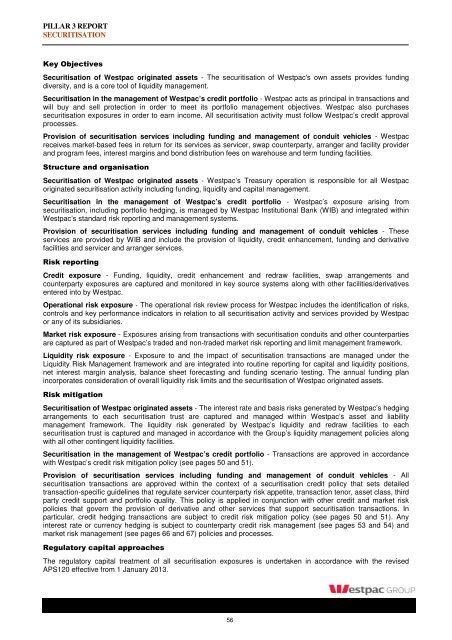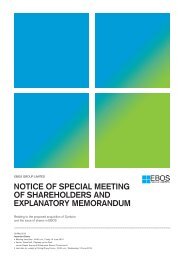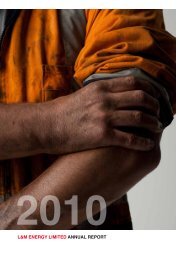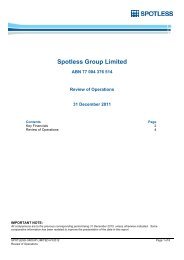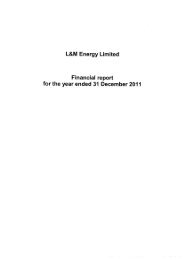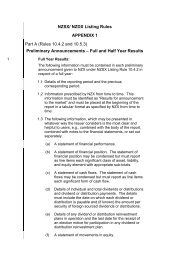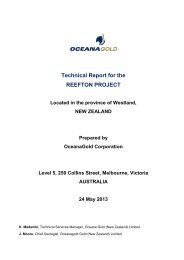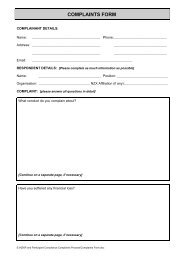Westpac Group Pillar 3 Report March 2013 - Iguana IR Sites
Westpac Group Pillar 3 Report March 2013 - Iguana IR Sites
Westpac Group Pillar 3 Report March 2013 - Iguana IR Sites
Create successful ePaper yourself
Turn your PDF publications into a flip-book with our unique Google optimized e-Paper software.
PILLAR 3 REPORT<br />
SECURITISATION<br />
Key Objectives<br />
Securitisation of <strong>Westpac</strong> originated assets - The securitisation of <strong>Westpac</strong>'s own assets provides funding<br />
diversity, and is a core tool of liquidity management.<br />
Securitisation in the management of <strong>Westpac</strong>’s credit portfolio - <strong>Westpac</strong> acts as principal in transactions and<br />
will buy and sell protection in order to meet its portfolio management objectives. <strong>Westpac</strong> also purchases<br />
securitisation exposures in order to earn income. All securitisation activity must follow <strong>Westpac</strong>’s credit approval<br />
processes.<br />
Provision of securitisation services including funding and management of conduit vehicles - <strong>Westpac</strong><br />
receives market-based fees in return for its services as servicer, swap counterparty, arranger and facility provider<br />
and program fees, interest margins and bond distribution fees on warehouse and term funding facilities.<br />
Structure and organisation<br />
Securitisation of <strong>Westpac</strong> originated assets - <strong>Westpac</strong>’s Treasury operation is responsible for all <strong>Westpac</strong><br />
originated securitisation activity including funding, liquidity and capital management.<br />
Securitisation in the management of <strong>Westpac</strong>’s credit portfolio - <strong>Westpac</strong>’s exposure arising from<br />
securitisation, including portfolio hedging, is managed by <strong>Westpac</strong> Institutional Bank (WIB) and integrated within<br />
<strong>Westpac</strong>’s standard risk reporting and management systems.<br />
Provision of securitisation services including funding and management of conduit vehicles - These<br />
services are provided by WIB and include the provision of liquidity, credit enhancement, funding and derivative<br />
facilities and servicer and arranger services.<br />
Risk reporting<br />
Credit exposure - Funding, liquidity, credit enhancement and redraw facilities, swap arrangements and<br />
counterparty exposures are captured and monitored in key source systems along with other facilities/derivatives<br />
entered into by <strong>Westpac</strong>.<br />
Operational risk exposure - The operational risk review process for <strong>Westpac</strong> includes the identification of risks,<br />
controls and key performance indicators in relation to all securitisation activity and services provided by <strong>Westpac</strong><br />
or any of its subsidiaries.<br />
Market risk exposure - Exposures arising from transactions with securitisation conduits and other counterparties<br />
are captured as part of <strong>Westpac</strong>’s traded and non-traded market risk reporting and limit management framework.<br />
Liquidity risk exposure - Exposure to and the impact of securitisation transactions are managed under the<br />
Liquidity Risk Management framework and are integrated into routine reporting for capital and liquidity positions,<br />
net interest margin analysis, balance sheet forecasting and funding scenario testing. The annual funding plan<br />
incorporates consideration of overall liquidity risk limits and the securitisation of <strong>Westpac</strong> originated assets.<br />
Risk mitigation<br />
Securitisation of <strong>Westpac</strong> originated assets - The interest rate and basis risks generated by <strong>Westpac</strong>’s hedging<br />
arrangements to each securitisation trust are captured and managed within <strong>Westpac</strong>’s asset and liability<br />
management framework. The liquidity risk generated by <strong>Westpac</strong>’s liquidity and redraw facilities to each<br />
securitisation trust is captured and managed in accordance with the <strong>Group</strong>’s liquidity management policies along<br />
with all other contingent liquidity facilities.<br />
Securitisation in the management of <strong>Westpac</strong>’s credit portfolio - Transactions are approved in accordance<br />
with <strong>Westpac</strong>’s credit risk mitigation policy (see pages 50 and 51).<br />
Provision of securitisation services including funding and management of conduit vehicles - All<br />
securitisation transactions are approved within the context of a securitisation credit policy that sets detailed<br />
transaction-specific guidelines that regulate servicer counterparty risk appetite, transaction tenor, asset class, third<br />
party credit support and portfolio quality. This policy is applied in conjunction with other credit and market risk<br />
policies that govern the provision of derivative and other services that support securitisation transactions. In<br />
particular, credit hedging transactions are subject to credit risk mitigation policy (see pages 50 and 51). Any<br />
interest rate or currency hedging is subject to counterparty credit risk management (see pages 53 and 54) and<br />
market risk management (see pages 66 and 67) policies and processes.<br />
Regulatory capital approaches<br />
The regulatory capital treatment of all securitisation exposures is undertaken in accordance with the revised<br />
APS120 effective from 1 January <strong>2013</strong>.<br />
56


